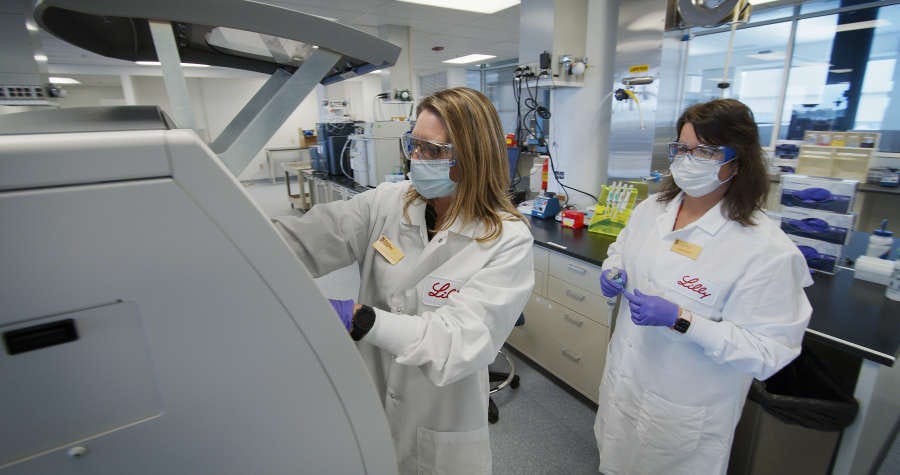Lilly Studies COVID-19 Drug in Diverse New Mexico
 The building block for the drug was based on an isolated sample from one of the first U.S. patients who recovered from COVID-19.
The building block for the drug was based on an isolated sample from one of the first U.S. patients who recovered from COVID-19.
Subscriber Benefit
As a subscriber you can listen to articles at work, in the car, or while you work out. Subscribe NowEli Lilly and Co.’s bamlanivimab has been infused more than 1,000 times in Indiana alone. The neutralizing antibody created by the Indianapolis-based pharma giant is given to people with mild to moderate COVID-19 infections at high risk of progressing to a severe case or hospitalization. A new study is now underway for bamlanivimab; retrofitted RVs will travel to the diverse state of New Mexico to turn any location into, essentially, a clinical research facility on wheels to evaluate how the drug performs in a real-world setting with a melting pot of patients.
Spanning rural to urban locations, the study in New Mexico will take advantage of the state’s highly diverse population, including Native Americans, African Americans, Hispanics and Asians. While the clinical studies for bamlanivimab included a diverse population, the New Mexico effort is a pragmatic study, meaning it analyzes how the drug performs in the healthcare environment and all of the variables that come with it.
“The idea with the New Mexico study is to evaluate how bamlanivimab works in a real-world, less controlled setting,” says Lilly COVID-19 Therapeutic Platform Leader Janelle Sabo. “It’s important once you launch a drug to look at pragmatically how it’s actually used, and what are the outcomes in patient populations that are [receiving infusions]. [The New Mexico study] will look at a variety of settings, which will also help us understand are they all equally effective, and are there pros and cons associated with any of them?”
Lilly will dispatch some of its custom retrofitted RVs to New Mexico; the vehicles are the brainchild of Sabo and her team as a method for Lilly to nimbly respond to the ever-changing dynamics of the pandemic. A single RV can transform any setting into a bamlanivimab infusion clinic within hours of rolling in; the drug is given intravenously (with an IV) for about one hour at hospital infusion centers, doctors’ offices or pop-up sites.
“It really is incredible; once [the RV] arrives on site, it can have an entire infusion clinic set up with between 11 and 15 chairs in just 35 minutes,” says Sabo. “The RVs aren’t marked, so you could easily pass one on the highway and not even know it—which is important, because we don’t want to be attracting attention or in any way advertising therapy, etc.”
The RVs were given their first test run in Lilly’s BLAZE-2 COVID-19 prevention trial that evaluated bamlanivimab’s ability to prevent or reduce the number of COVID-19 infections in a nursing home that was having an active outbreak. Results of the eight-week study showed that residents who received the treatment had up to an 80% lower risk of contracting COVID-19 compared to residents in the same facility who were given a placebo.
“Nursing homes aren’t a traditional place to do clinical research. It’s never really done; they’re not set up in that way,” says Sabo. “At Lilly, we had to figure out how to bring a clinical study to a nursing home, so my team and I developed the idea of using an RV and transforming it into a mobile research unit.”
From concept to the first deployment, the RV project took only 30 days. The short time frame is evidence of a characteristic that Sabo says has defined Lilly’s COVID-19 response: speed.
“It’s been a really amazing journey,” says Sabo. “Traditionally, drug development takes seven to 10 years to take a drug to market. We did it [with bamlanivimab] in under seven months and never compromised safety and made sure we were making science-driven decisions, and I think that’s something to be very proud of.”
Lilly worked with Vancouver-based AbCellera to develop bamlanivimab; the building block for the drug was based on an isolated sample from one of the first U.S. patients who recovered from COVID-19. Sabo advises Hoosiers have a plan in case they contract COVID-19 and know the closest infusion clinic.
“[Lilly’s effort] wasn’t just about finding an option for COVID-19 therapy; we were really focused on options that could improve outcomes—keep patients out of the hospital and keep them from dying,” says Sabo. “I’m really proud of the work we did at Lilly to bring bamlanivimab to Emergency Use Authorization and also in the work we did with the nursing home study. I think what we’ve found is that the molecules we selected and brought forward truly are changing the landscape and give patients more than just hope in terms of their ability to survive and have better outcomes.”
Sabo explains the basics of how bamlanivimab works and why it’s called a “neutralizing” antibody.
Sabo says the most important advice is to have a plan in case you contract COVID-19, because time is critical for treatments, including bamlanivimab.
